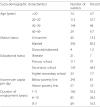2. Davies KG, Asanga U, Nku CO, Osim EE. Effect of chronic exposure to welding light on Calabar welders. Niger J Physiol Sci. 2007; 22(1–2):55–8. PMID:
18379619.
3. Sabitu K, Iliyasu Z, Dauda MM. Awareness of occupational hazards and utilization of safety measures among welders in Kaduna Metroplois. Northern Nigeria Ann Afr Med. 2009; 8(1):46–51. DOI:
10.4103/1596-3519.55764. PMID:
19763007.
4. Tadesse S, Bezabih K, Destaw B, Assefa Y. Awareness of occupational hazards and associated factors among welders in Lideta Sub-City, Addis Ababa. Ethiopia J Occup Med Toxicol. 2016; 11:15. DOI:
10.1186/s12995-016-0105-x. PMID:
27051458.
5. Budhathoki SS, Singh SB, Sagtani RA, Niraula SR, Pokharel PK. Awareness of occupational hazards and use of safety measures among welders: a cross-sectional study from eastern Nepal. BMJ Open. 2014; 4(6):e004646. DOI:
10.1136/bmjopen-2013-004646. PMID:
24889850.
6. Vaidya SN. Lehtinen S, Rantanen J, Elgstrand K, Liesievuori J, Peurala M, editors. Occupational safety and situation in Nepal. Challenges to occupational health services in the regions: the national and international responses: proceedings of a workshop. 2005. Helsinki: Finnish Institute of Occupational Health.
7. Pyakurel P, Karki P, Lamsal M, Ghimire A, Pokharel PK. Cardiovascular risk factors among industrial workers: a cross–sectional study from eastern Nepal. J Occup Med Toxicol. 2016; 11:25. DOI:
10.1186/s12995-016-0109-6. PMID:
27182279.
8. Singh SB, Bhatta N, Jha N, Pokharel PK. Respiratory morbidities of jute mill workers in Nepal. Heal Renaiss. 2012; 10(3):181–6.
9. Joshi SK, Dahal P. Occupational health in small scale and household industries in Nepal: a situation analysis. Kathmandu Univ Med J. 2008; 6(22):152–60.
10. Joshi SK, Shrestha S, Shrestha R, Vaidya S. Health status of child laborers in Nepal. Int J Occup Saf Heal. 2012; 2(1):31–8.
11. Joshi SK, Shrestha S, Vaidya S. Occupational safety and health studies in Nepal. Int J Occup Saf Heal. 2011; 1:19–26.
12. Joshi SK, Dahal P, Poudel A, Sherpa H. Work related injuries and musculoskeletal disorders among child workers in the brick kilns of Nepal. Int J Occup Saf Heal. 2013; 3(3):2–7.
13. Isah EC, Okojie OH. Occupational health problems of welders in Benin City. Nigeria J Med Biomed Res. 2006; 5(1):64–9.
15. El-Zein M, Infante-Rivard C, Malo J, Gautrin D. Is metal fume fever a determinant of welding related respiratory symptoms and/or increased bronchial responsiveness? A longitudinal study. Occup Env Med. 2005; 62:688–94. DOI:
10.1136/oem.2004.018796. PMID:
16169914.
17. Chauhan A, Anand T, Kishore J, Danielsen TE, Ingle GK. Occupational hazard exposure and general health profile of welders in rural Delhi. Indian J Occup Environ Med. 2014; 18(1):21–6. DOI:
10.4103/0019-5278.134953. PMID:
25006312.
18. Vatani J, Ghasemzadeh KH, Raei M. Assessment of ultraviolet radiation exposure of welders working in Shahrud City, Iran, 2014. J Occup Heal Epidemiol. 2013; 2(4):2–6.
19. Berhe A, Yemane D, Gebresilassie A, Terefe W, Ingale L. Magnitude of Occupational Injuries and Associated Factors among Small- Scale Industry Workers in Mekelle City, Northern Ethiopia. Occup Med Heal Aff. 2014;3(3):1000197.
20. Eze BI, Okoye O, Aguwa EN. Awareness and Utilization of Welders’ Personal Protective Eye Devices and Associated Factors Finding and Lessons From a Nigerian Population. Workplace Health Saf. 2015;63(4):170–78.
21. Division P. Health M, Era N. 2011. Nepal: International ICF.
22. Ministry of Health and Population, Government of Nepal, New Era. Nepal Demographic and Health Survey 2011. 2011. Kathmandu: Ministry of Health and Population, Government of Nepal, New Era;p. 149–152.
23. Government of Nepal, National Planning Commission. Nepal Millenium Development Goals Progress report 2013. 2013.
24. El-Zein M, Malo J-L, Infante-Rivard C, Gautrin D. Prevalence and association of welding related systemic and respiratory symptoms in welders. Occup Environ Med. 2003; 60:655–61. DOI:
10.1136/oem.60.9.655. PMID:
12937186.
25. Bergner M. Developing Nepal’ s Hydroelectric Resources : Policy Alternatives. Charlottesville: Frank Batten School of Leadership and Public Policy, University of Virginia; 2013.
26. Rongo LMB, Barten F, Msamanga GI, Heederik D, Dolmans WMV. Occupational exposure and health problems in small-scale industry workers in Dar es Salaam, Tanzania : a situation analysis. Occup Med (Chic Ill). 2004; 54:42–6. DOI:
10.1093/occmed/kqh001.
27. Tenakate T. Occupational exposure to ultraviolet radiation: a health risk assessment. Rev Environ Health. 1999; 14:187–209. PMID:
10746733.
28. Jani V, Mazumdar V. Prevalence of respiratory morbidity among welders in unorganized sector of Baroda City. Indian J Occup Environ Med. 2004; 8(1):16–21.
29. Sharifian SA, Loukzadeh Z, Shojaoddiny-ardekani A, Aminian O. Pulmonary adverse effects of welding fume in automobile assembly welders. Acta Med Iran. 2011; 49(2):98–102. PMID:
21598218.
30. Stoleski S, Bislimovska K, Jordan M, Dragan M, Snezana R. Prevalence of chronic respiratory symptoms, ventilatory capacity and bronchial responsiveness in welders. European Respiratory Society Annual Congress 2012. 2012. p. 4361.
31. Erhabor GE, Fatusi S, Obembe OB. Pulmonary function in arc-welders in Ile-Ife, Nigeria. East Afr Med J. 2001;78(9):361–64.
32. Prabhu GV, Nateshan B, Ferriera A, Kulkarni M, Vaz F. Morbidity among welders in the shipbuilding industry, Goa, India: A Cause for Concern. 30th International Congress on Occupational Health. 2012. p. 7659.
33. Kumar GS, Dharanipriya A. Prevalence and pattern of occupational injuries at workplace among welders in coastal south India. Indian J Occup Environ Med. 2014; 18(3):135–9. DOI:
10.4103/0019-5278.146911. PMID:
25598619.
34. Magnusson M, Pope M. A review of the biomechanics and epidemiology of working postures. J Sound Vib. 1998; 215(4):965–76. DOI:
10.1006/jsvi.1998.1677.








 PDF
PDF Citation
Citation Print
Print



 XML Download
XML Download